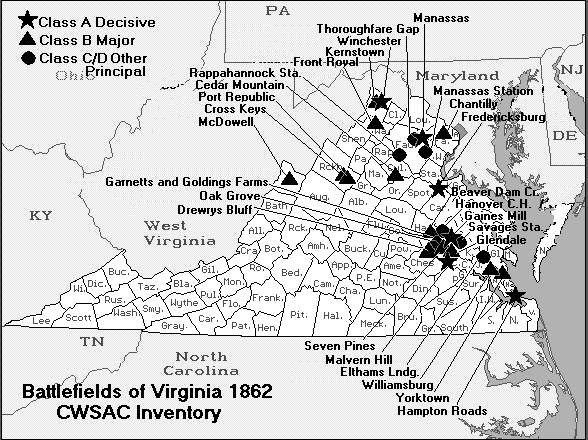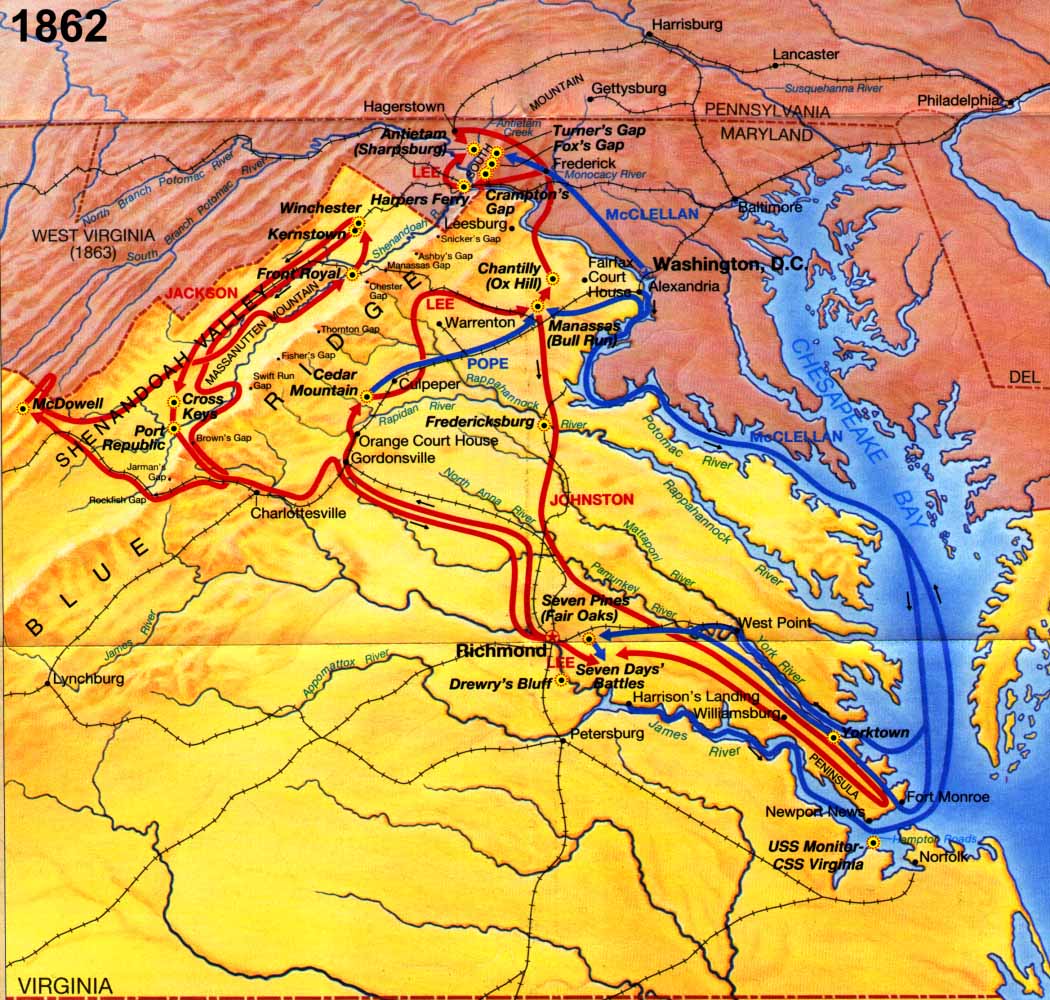|
2nd Battle of Bull Run / Second Battle of Bull Run
| 2nd Battle of Bull Run Map |

|
| Civil War Second Battle of Bull Run Battlefield Map |
In August 1862, Union and Confederate armies converged for a second time on the plains of Manassas.
The naive enthusiasm that preceded the earlier encounter was gone. War was not the holiday outing or grand adventure envisioned
by the young recruits of 1861. The contending forces, now made up of seasoned veterans, knew well the realities of war. The
Battle of Second Manassas, covering three days, produced far greater carnage-3,300 killed-and brought the Confederacy to the
height of its power. Still the battle did not weaken Northern resolve. The war's final outcome was yet unknown and it would
be left to other battles to decide whether the sacrifice at Manassas was part of the high price of Southern independence,
or the cost of one country again united under the national standard.
After the Union defeat at Manassas in July 1861, Gen. George
B. McClellan took command of the Federal forces in and around Washington and organized them into a formidable fighting machine
- the Army of the Potomac. In March 1862, leaving a strong forces to cover the capital, McClellan shifted his army by water
to Fort Monroe on the tip of the York-James peninsula, only 100 miles southeast of Richmond. Early in April he advanced toward
the Confederate capital.
Anticipating such a move, the Southerners abandoned the Manassas area and marched to meet
the Federals. By the end of May, McClellan's troops were within sight of Richmond. Here Gen. Joseph E. Johnston's Confederate
army assailed the Federals in the bloody but inconclusive Battle of Seven Pines. Johnston was wounded, and President Davis
placed Gen. Robert E. Lee in command. Seizing the offensive, Lee sent his force (now called the Army of Northern Virginia)
across the Chickahominy River and, in a series of savage battles, pushed McClellan back from the edge of Richmond to a position
on the James River.
Second Bull Run: The Campaign
At the same time, the scattered Federal forces in Northern
Virginia were organized into the Army of Virginia under the command of Gen. John Pope, who arrived with a reputation freshly
won in the war's western theater. Gambling that McClellan would cause no further trouble around Richmond, Lee sent Stonewall
Jackson's corps northward to "suppress" Pope. Jackson clashed indecisively with part of Pope's troops at Cedar Mountain on
August 9. Meanwhile, learning that the Army of the Potomac was withdrawing by water to join Pope, Lee marched with Gen. James
Longstreet's corps to bolster Jackson. Pope successfully foiled Lee's attempts to gain a tactical advantage on the Rapidan
by withdrawing his army to the north bank of the Rappahannock River. Lee knew that if he was to defeat Pope he would have
to strike before McClellan's army arrived in Northern Virginia. On August 25 Lee boldly started Jackson's wing on a march
of over 50 miles, around the Union right flank to strike at Pope's rear.
Two days later, Jackson's veterans seized
Pope's supply depot at Manassas Junction. After a day of wild feasting, Jackson burned the Federal supplies and moved to a
position in the woods at Groveton near the old Manassas battlefield.
Second Bull Run: August 28
Pope, stung by the attack on his supply base, abandoned the line
of the Rappahannock and headed toward Manassas to "bag" Jackson. At the same time, Lee was moving northward with Longstreet's
corps to reunite his army. On the afternoon of August 28, to prevent the Federal commander's efforts to concentrate at Centreville
and to bring Pope to battle, Jackson order his troops to attack a Union column as it marched past on the Warrenton Turnpike.
This savage fight at Brawner's Farm lasted until dark.
Convinced that Jackson was isolated, Pope ordered his columns
to converge on Groveton. He was sure that he could destroy Jackson before Lee and Longstreet could intervene.
Second Bull Run: August 29
On the 29th Pope's army found Jackson's men posted along an unfinished
railroad grade, north of the turnpike. All afternoon, in a series of uncoordinated attacks, Pope hurled his men against the
Confederate position. In several places the northerners momentarily breached Jackson's line, but each time were forced back.
During the afternoon, Longstreet's troops arrived on the battlefield and, unknown to Pope, deployed on Jackson's
right, overlapping the exposed Union left. Lee urged Longstreet to attack, but "Old Pete" demurred. The time was just not
right, he said.
| 2nd Battle of Bull Run, Virginia Civil War Map |

|
| Map of 1862 Battle of Bull Run, aka 2nd Bull Run |
Second Bull Run: August 30
The morning of August 30 passed quietly. Just before noon, erroneously
concluding the Confederates were retreating, Pope ordered his army forward in "pursuit". The pursuit however, was short-lived.
Pope found that Lee had gone nowhere. Amazingly, Pope ordered yet another attack against Jackson's line. Fitz-John Porter's
corps, along with part of McDowell's, struck Starke's division at the unfinished railroad's "Deep Cut." The southerners held
firm, and Porter's column was hurled back in a bloody repulse.
Seeing the Union lines in disarray, Longstreet pushed
his massive columns forward and staggered the Union left. Pope's army was faced with annihilation. Only a heroic stand by
northern troops, first on Chinn Ridge and then once again on Henry Hill, bought time for Pope's hard pressed Union forces.
Finally under cover of darkness the defeated Union army withdrew across the Bull Run toward the defenses of Washington. Lee's
bold and brilliant Second Manassas campaign opened the way for the south's first invasion for the north, and a bid for foreign
intervention.
Sources: National Park Service; Manassas National Battlefield Park; Center of Military History, United States Army, Washington, D.C.
|

